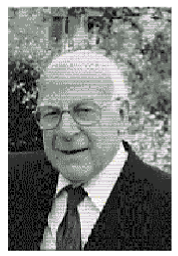
History of Miramodus and molecular models in Edinburgh
Beevers models and Miramodus
Models in Edinburgh
There has been a strong tradition of model making in the Chemistry Department of Edinburgh University. Alexander Crum Brown, Professor of Chemistry from 1869-1908, was a character of tremendous imagination and ingenuity. As a child, he was fascinated by models and inventions and he had a life-long interest in knots and a kind of 3D knitting. He built models of all kinds and some of his attempts to model crystal growth with assemblies of fused spheres still survive. Against much opposition, he introduced his "graphic formulae" for organic molecules; these are essentially those still in use today, showing both the valency and the connectivity of atoms.One remarkable survival is a model constructed with wool balls and knitting needles to illustrate the rock salt structure. It shows the correct arrangement of ions, which was only proved much later by X-ray diffraction. It also shows his insight into novel possibilities for crystal structures at a time when most scientists believedthat all solids were molecular in nature. Crum Brown is commemorated now in the title of the Chair of Inorganic Chemistry, while his structural representations remain an inspiration.In the Year the Crum Brown retired, Cecil Arnold Beevers was born in Manchester, moving with his parents to Liverpool a few months later. He took a degree in Physics at the University of Liverpool in 1929, and then became involved, under the influence of Lawrence Bragg in Manchester, in research in crystallography. With Henry Lipson, he made major contribution in the Beevers-Lipson Strips. This method of computing Fourier synthesis was a great aid in the solution of crystal structures from diffraction data, and was later incorporated as the basis of many computer programs. His solution of many important crystal structures added greatly to our understanding of matter.
In 1938, Dr Beevers became the Dewar Fellow at Edinburgh University, and models were once more to the fore in the Chemistry Department, Over the years Dr Beevers experimented with many ways of making models, but found most to be bulky, unattractive, inaccurate or impermanent. So he devised machines capable of drilling very small balls with great precision, and in the early 1960's he made his first models with 7mm acrylic balls to a scale of 1cm=1Å.
During this time, Dr Beevers had also become actively concerned with the welfare of disabled people, and he was for many years a manager of the Edinburgh Cripple Aid Society, which ran a centre for physically handicapped people in Simon Square. Dr Beevers was able to combine his interests by involving the people attending the day centre in model-making, and by the time he retired from the university in 1977, there were seven people at the Simon Square Day Centre making models which were sent all over the world. In 1979 the administration of the Simon Square Day Centre passed from he Edinburgh Cripple Aid Society to the Lothian Regional Council, and the model making continued to be a valued part of the Centre's activities. Meanwhile, Edinburgh University was making arrangements for the continuation of Dr Beever's work and ideals. The result was the establishment in 1980 of a self-financing unit within the Chemistry Department - the Beevers Miniature Models Unit, later becoming known simply as BMM. Sadly, Arnold Beevers died on 16 January 2001, but left a great legacy in the form of his models.


